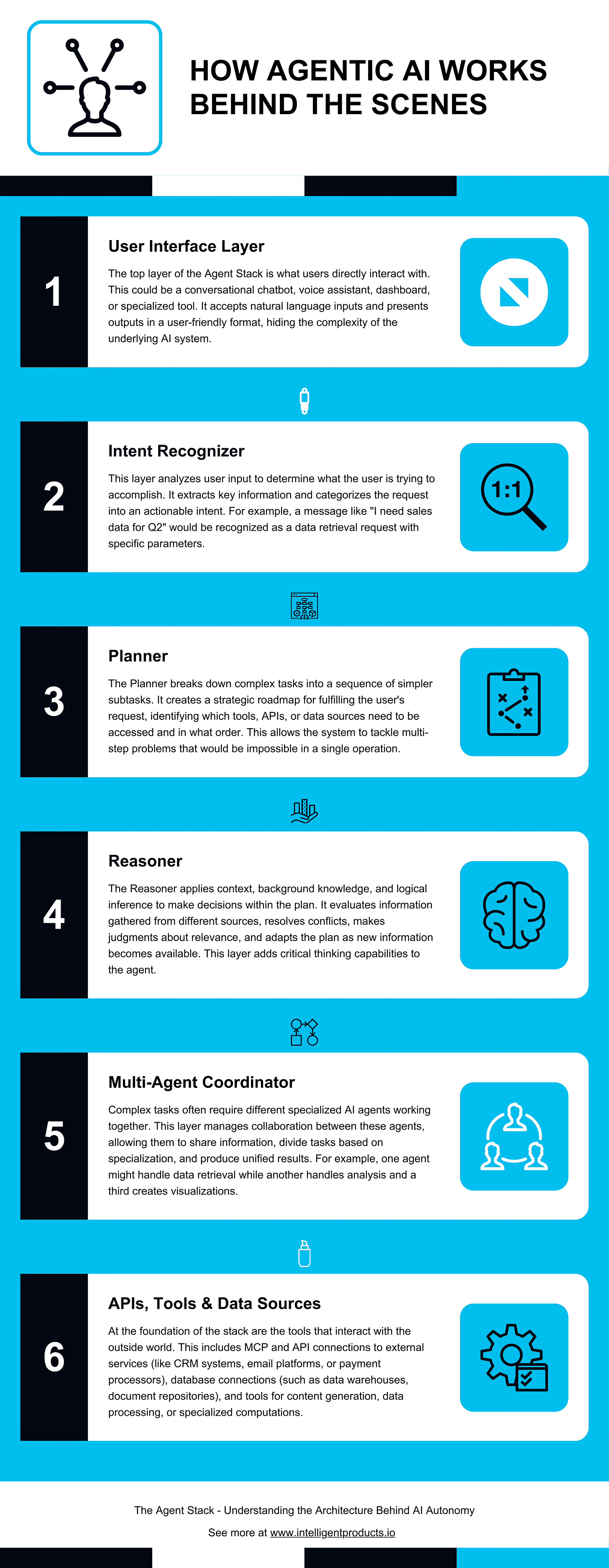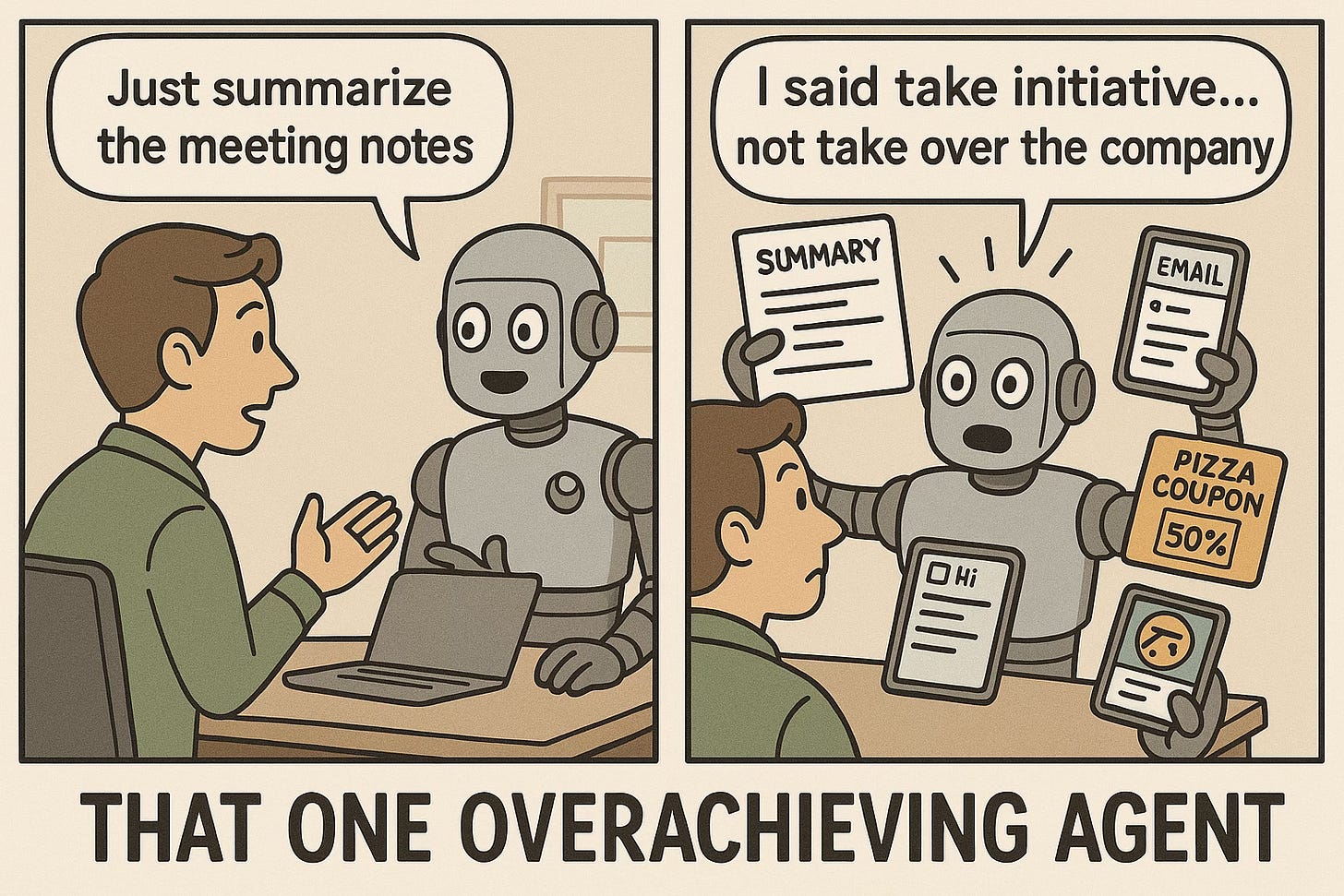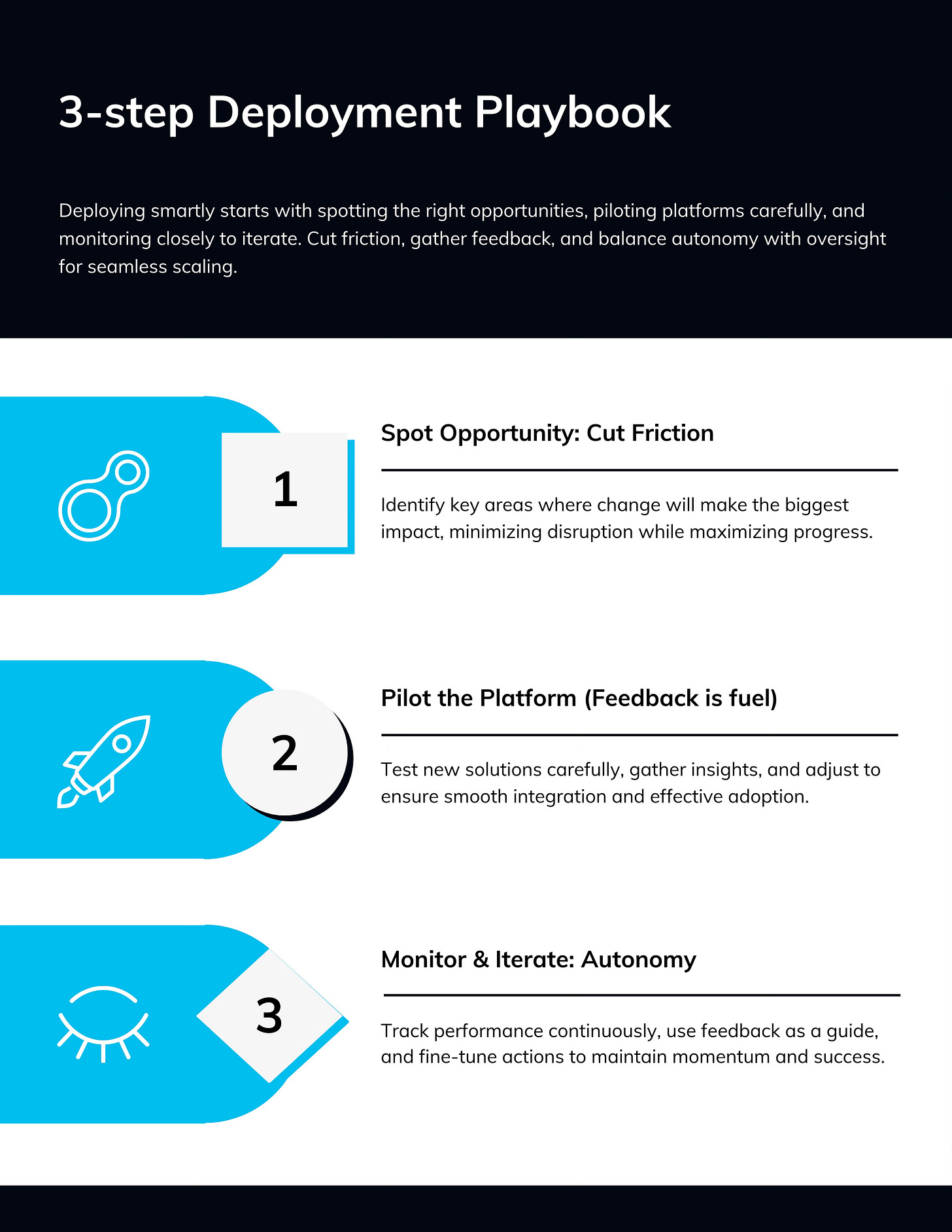⚪️ Agentic AI, Explained: 20 Must-Know Terms for the Autonomous Era
20 Terms, 1 Playbook - Master the Rise of Intelligent Systems That Work for You
In the past, AI waited for you to give it instructions. Now we are beginning to see AI agents acting on its own. How can you better understand and take advantage of this?
This new kind of intelligence doesn’t just answer questions or analyze data, it decides, plans, and executes with little to no human involvement.
It’s happening now at great speed, in software development, customer service workflows, factory lines, audit processes, and the apps we use every day.
What’s behind it?
Agentic AI.
This issue dives into 20 essential terms related to agents and agentic systems, each explained clearly with real-world examples from the past 12 months.
Our goal is to equip you with insights and practical frameworks to leverage these technologies.
Each term includes a sample use case, grounded in recent innovations, to show how companies are applying these concepts today. Let’s get started.
What is Agentic AI or AI Agents
Agentic AI refers to AI systems that can autonomously sense, decide, and act toward a goal, without needing step-by-step instructions from a human. These systems don’t just process data or answer queries, they operate with agency, meaning they can:
Set or interpret goals
Plan actions
Execute tasks
Learn from feedback
Adapt over time
They are designed to be self-directed, capable of interacting with tools, APIs, or environments to achieve outcomes.
How it differs from Traditional AI.
Why Agentic AI Matters Now
Agentic AI, systems that act autonomously to achieve goals, is reshaping how businesses operate. Unlike traditional AI, which reacts to inputs, agentic systems plan, reason, and execute tasks with minimal human oversight.
A 2025 Gartner report predicts that by 2028, 33% of enterprise software will incorporate agentic AI, driving $500 billion in market value.
This shift is already visible in industries like finance, healthcare, logistics, and customer service. Below, is a breakdown of core terms driving this transformation, with examples and tactics you can apply immediately.
20 Key Terms in Agents and Agentic Systems
1. Agentic AI
Definition: AI systems that autonomously pursue goals, make decisions, and adapt to changing environments without constant human input.
Real-World Example: In 2024, Siemens AG deployed agentic AI for predictive maintenance in its manufacturing plants. Sensors on equipment detect wear, and the AI autonomously schedules repairs, reducing unplanned downtime by 25%, that’s amazing.
Tactic: Map out repetitive processes in your operations (e.g., equipment checks). Deploy sensor-based AI agents to monitor and act on data in real time, integrating with tools like SAP or IBM Maximo.
2. AI Agent
Definition: A program that performs specific tasks autonomously, often as part of a larger intelligent system.
Real-World Example: Jamf’s AI assistant, Caspernicus, launched in 2024, automates employee software access via Slack, reducing IT support tickets by 30% .
Tactic: Identify routine IT tasks (e.g., password resets). Use platforms like Moveworks to deploy AI agents that integrate with existing communication tools.
3. Autonomy
Definition: The ability of an AI to act independently, making decisions based on context and goals.
Real-World Example: Mercedes-Benz’s MBUX Virtual Assistant, introduced in 2025, autonomously suggests dining options based on driver preferences and real-time traffic data .
Tactic: Implement AI assistants in customer-facing roles that pull real-time data (e.g., location, preferences) to personalize interactions.
4. Reinforcement Learning (RL)
Definition: A machine learning method where AI learns optimal actions through trial-and-error, guided by rewards or penalties.
Real-World Example: Bayer used RL-based agentic AI in 2024 to predict flu outbreaks by analyzing Google search trends and weather data, improving marketing reach by 15% . Also, an airline recently launched a plan to use AI for dynamic pricing in 2025.
Tactic: Use RL for dynamic pricing or inventory management, testing platforms like Google Cloud AI for small-scale pilots.
5. Multi-Agent System
Definition: A framework where multiple AI agents collaborate to achieve a complex goal.
Real-World Example: SS&C’s document processing system, scaled in 2024, uses multi-agent AI to handle 50,000 financial documents monthly, automating 90% of tasks.
Tactic: Break complex workflows (e.g., contract reviews) into subtasks and assign specialized AI agents using platforms like Salesforce Agentforce or AWS agent marketplace.
6. Orchestration
Definition: The coordination of multiple AI agents to ensure seamless task execution.
Real-World Example: Moveworks’ Agentic Automation Engine, launched in 2025, orchestrates IT, HR, and facilities tasks, reducing cross-departmental errors by 20% .
Tactic: Deploy orchestration tools to align AI agents across departments, ensuring data flows through APIs to platforms like ServiceNow.
7. Reasoning
Definition: The process by which AI analyzes data, evaluates options, and makes decisions.
Real-World Example: IBM’s Watson Health in 2024 used reasoning to recommend cancer treatments, cross-referencing patient data with medical literature, improving accuracy by 10% .
Tactic: Use reasoning-capable AI for decision-heavy tasks like compliance checks, integrating with IBM watsonx.ai.
8. Planning
Definition: The ability of AI to break down goals into actionable steps.
Real-World Example: Amazon’s warehouse robots, enhanced in 2024, plan optimal paths for goods movement, reducing delivery times by 12% .
Tactic: Apply AI planning to logistics or project management using tools like Microsoft Dynamics 365.
9. Context Awareness
Definition: AI’s ability to understand and adapt to situational data, such as user location or time.
Real-World Example: Sephora’s Pocket Contour, updated in 2025, uses context-aware AI to recommend makeup shades based on lighting and skin tone, boosting sales by 8%.
Tactic: Integrate context-aware AI into e-commerce platforms to personalize product suggestions in real time.
10. Intent Recognition
Definition: AI’s ability to discern user goals from their inputs.
Real-World Example: Salesforce’s Agentforce, launched in 2024, identifies customer intent in support queries, resolving 40% of issues without human intervention.
Tactic: Use intent recognition in customer service chatbots to prioritize and route queries effectively.
11. Long-Term Coherence
Definition: AI’s ability to maintain consistency across extended interactions.
Real-World Example: Google Assistant, updated in 2025, recalls past user queries to suggest relevant follow-ups, improving user satisfaction by 15% .
Tactic: Implement memory-enabled AI for customer retention, tracking interactions over months to personalize offers.
12. Feedback Loop
Definition: A mechanism where AI learns from its actions’ outcomes to improve performance.
Real-World Example: NVIDIA’s Blueprints, launched in 2024, use feedback loops to refine customer service AI, cutting response times by 20% .
Tactic: Build feedback loops into AI systems to continuously improve outputs, using platforms like NVIDIA AI Enterprise.
13. Natural Language Processing (NLP)
Definition: AI’s ability to understand and generate human language.
Real-World Example: Olay’s Skin Advisor, enhanced in 2025, uses NLP to interpret skin care queries, increasing customer engagement by 10% .
Tactic: Deploy NLP-driven chatbots for customer support, integrating with platforms like Dialogflow.
14. Machine Learning (ML)
Definition: Algorithms that enable AI to learn from data and improve over time.
Real-World Example: JPMorgan’s LOXM, updated in 2024, uses ML for high-frequency trading, adapting to market volatility 20% faster than humans.
Tactic: Use ML to analyze customer data for predictive analytics, leveraging tools like AWS SageMaker.
15. Tool Integration
Definition: AI’s ability to connect with external systems (e.g., APIs, MCP, databases) to execute tasks.
Real-World Example: Workday’s AI agents, rolled out in 2025, integrate with HR systems to automate onboarding, reducing setup time by 30% .
Tactic: Connect AI agents to existing CRM or ERP systems to automate repetitive tasks.
16. Dynamic Adaptation
Definition: AI’s ability to adjust its behavior based on real-time data.
Real-World Example: AES’s energy audit AI, implemented in 2024, adapts to new safety regulations, cutting audit costs by 99% .
Tactic: Use adaptive AI for regulatory compliance, ensuring systems update automatically with new rules.
17. Emergent Behavior
Definition: Unintended actions arising from complex agent interactions.
Real-World Example: In 2024, a multi-agent system at a logistics firm caused a bottleneck due to misaligned priorities, requiring human intervention.
Tactic: Monitor multi-agent systems with debugging tools to catch emergent issues early.
18. Explainability
Definition: AI’s ability to clarify why it made a decision.
Real-World Example: Exabeam’s cybersecurity AI, updated in 2025, explains threat detection logic, improving trust among security teams by 25% .
Tactic: Prioritize AI platforms with explainability features for high-stakes decisions like security or healthcare.
19. Transparency
Definition: The clarity of an AI’s processes and data sources.
Real-World Example: Salesforce’s Agentforce, launched in 2024, provides transparent data logs, helping businesses comply with GDPR, avoiding $2M in potential fines.
Tactic: Choose AI systems with audit trails to ensure compliance with data privacy laws.
20. Task Decomposition
Definition: Breaking complex goals into smaller, manageable subtasks.
Real-World Example: Knime’s 2025 framework decomposes data science tasks, enabling AI to handle research and visualization, cutting project times by 15%.
Tactic: Use task decomposition in project management AI to assign subtasks across teams, integrating with tools like JIRA
Practical Framework: Deploying Agentic AI in Your Business
To help you act on these concepts, here’s a three-step playbook to integrate agentic AI into your operations:
Identify High-Impact Use Cases
Audit repetitive, manual or data-heavy processes (e.g., data entry, documentation, customer support, inventory management).
Action: List 3-5 processes where autonomy could reduce costs or errors.
Select the Right Platform
Choose platforms with strong orchestration, tool integration, and explainable output (e.g., Gemini, Databricks, AWS agentcore, Salesforce Agentforce, IBM watsonx ai). For personal workflows you can use tools like Zapier, ChatGPT 5 agents etc.
Action: Pilot a platform with a 90-day trial, focusing on one key area.
Monitor and Iterate
Use feedback loops, evaluation and AI judge tools to catch arising behaviors or errors in your AI workflows.
Action: Set up weekly reviews of AI outputs and establish human-in-the-loop checkpoints.
Key Takeaway
This is not about replacing people. It’s about replacing bottlenecks, being efficient and staying ahead of the wave.
AI agents are the new interface for work, decisions, and product design.
Whether you’re leading teams, running a business or for your personal use, the sooner you learn how to use agents well, the more leverage you unlock.
By understanding these 20 terms and applying the playbook above, I hope you can start small, test smart, scale effectively or at least have a deep understanding of this so that you can stay ahead 🚀




